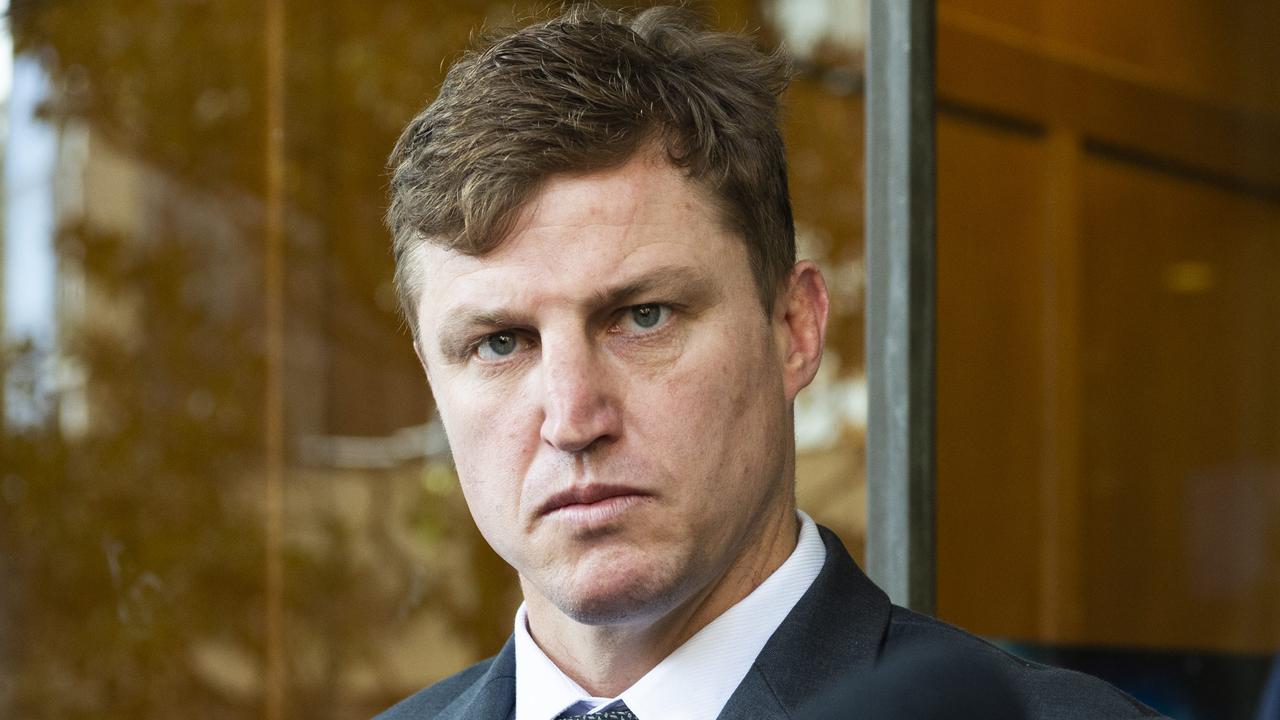
This transcript was prepared by a transcription service. This version may not be in its final form and may be updated.
Kate Linebaugh: You know that feeling when you see a post or a thread that just catches your eye and you’re like, “What?” That’s what happened to our colleague Rolfe Winkler this spring.
Here’s what he saw.
Rolfe Winkler: It’s titled Adderall For All.
Kate Linebaugh: The post was anonymous, written by someone who said they’d worked at a startup called Cerebral. Cerebral launched in 2020 with a mission to transform mental healthcare in America. And it took off, signing up thousands of patients and securing hundreds of millions of dollars from Silicon Valley investors. But the post Rolfe stumbled upon raised a lot of questions.
Rolfe Winkler: It said, “You have to be really comfortable prescribing stimulants. Almost all your patients will want Adderall. And if you don’t prescribe a stimulant, you’ll get an email from the “quality team” asking you to write a note justifying why you chose a non-stimulant.”
Kate Linebaugh: Adderall is used to treat ADHD. And it’s a controlled substance. Its use is regulated by the government because it’s potentially addictive and prone to abuse. And the post suggested that Cerebral was pressuring clinicians to prescribe it.
Rolfe Winkler: I saw that and I thought, “That’s interesting. I wonder if that’s true.”
These are anonymous reviews. You have to go verify them.
Kate Linebaugh: Over the next few months, Rolfe teamed up with reporter, Khadeeja Safdar. Together, they found former employees who had similar concerns about Cerebral.
Khadeeja Safdar: I spoke to employees who cried on the phone because they were so stressed out that they weren’t treating patients properly, about just having that on their conscience, and then just being really guilty about being part of that.
Rolfe Winkler: A bunch of them told me the same thing, that they felt uncomfortable on the platform. They felt pressured to prescribe stimulants.
Kate Linebaugh: Rolfe and Khadeeja have since reported story after story showing how Cerebral’s focus on growing its business interfered with its clinical mission.
Rolfe Winkler: Silicon Valley loves to move fast and break things, like an Uber, like a WeWork, and that’s how they grow really big. It’s another thing to take that playbook and do it for a service that prescribes drugs that are prone to abuse.
Khadeeja Safdar: They wanted the top line numbers to grow, which is they wanted more patients to come in through the doors, more signups.
Kate Linebaugh: And their reporting unleashed a wave of scrutiny on Cerebral.
Speaker 4: The company exploded in popularity during the pandemic, but it’s now facing a Department of Justice investigation over how it prescribed drugs like Adderall.
Speaker 5: It’s a former executive, has filed a lawsuit now claiming he was fired for objecting to company practices.
Speaker 6: The San Francisco startup with more than 200,000 patients has sent a memo to employees announcing job cuts are in the works this month. How can the company backed by SoftBank, Silver Lake, and others get back on track?
Kate Linebaugh: Cerebral says it provides mental healthcare to people who might not otherwise have access and that providing high quality care is the company’s highest priority. It also said its providers use their independent professional judgment when making clinical decisions. In interviews with former employees, patients, and investors, Rolfe and Khadeeja heard many stories.
Speaker 7: Going into Cerebral, I just thought I was going to be making a difference, helping people with anxiety and depression.
Shelly Balky: We were going to make quality, affordable, mental healthcare easily accessible.
Karl Sjogren: Technology was going to be the way to make it broadly accessible.
Speaker 10: I thought, “That just sounds like Uber for healthcare.”
Aike Ho: That is a very slippery slope that could go very wrong.
Shefi Lodi: Cerebral is a place where people go get 10-minute appointments and walk out with a controlled substance prescription.
Rolfe Winkler: They offered to pay you more money if you were willing to prescribe Adderall?
Speaker 13: Yeah.
Speaker 14: It’s only natural that you are incentivized to sell as much controlled substance as possible.
Karl Sjogren: I’m not going to ruin somebody’s life because you want to increase your numbers, and that’s what I felt it was like.
Aike Ho: My son is not Anthony. My son is patient 852922-7. That’s my son to them.
Kate Linebaugh: Over four episodes, Ralph and Khadeeja will take us inside Cerebral, to explore the company’s origins, to meet former staff, and to try to figure out whether Cerebral’s focus on growth interfered with patient care.
From The Journal, this is Uncontrolled Substances: The Cerebral Story. I’m Kate Linebaugh. This is Part One: Subscribe and Prescribe.
It was a Tuesday night in San Francisco back in 2018, and a guy named Karl Sjogren was out at one of his regular haunts.
Speaker 14: Hi, welcome to Hi Tops. May I see your ID?
Karl Sjogren: Hi Tops is a bar in San Francisco. They call it Hi Tops, but there aren’t really a lot of tops there.
Kate Linebaugh: It’s a gay sports bar, with flat screen TVs, trivia nights and weekly go-go dancing. And Karl says that that night in 2018, he met a man named Kyle Robertson.
Karl Sjogren: It was a casual Tuesday of everyone hanging out post trivia. And it was everyone milling around, meeting the person next to them. And Kyle stands out. He’s good looking, muscular. I’d actually met him a year before at a Pride party and I was like, “I think I’ve met you before. Good to see you, girl.”
Kate Linebaugh: Robertson was in his mid 20s. He worked three years at Accenture, the management consulting firm, and went on to an MBA program at Wharton Business School. But he dropped out to move to San Francisco and start a company.
Karl Sjogren: Kyle was living in a group house because it had cheap rent and he was going to be the next big founder and this was why he came here. And I was like, “Well, to do what? Give me your elevator pitch.”
Kate Linebaugh: Robertson wanted to build a telehealth company that could connect patients with clinicians and therapists online, one that could deliver medications to patients’ doors, all for a monthly fee. Karl had worked in marketing for companies like Google and Facebook, and when he heard Robertson’s pitch, he thought it had potential.
Karl Sjogren: And I was like, “Oh, really? Wow, this should be more accessible and this is a good business model and, oh my God, drugs, you could mail them to people.” There was clear potential. I just knew there was an opportunity there and for me it wasn’t let’s create the next big company. It was there’s probably a great way to do this well and help a lot of people.
Kate Linebaugh: We reached out to Robertson to get his take on this meeting and a number of other parts of our series, but through a spokesperson, he declined to comment or be interviewed.
After hearing Robertson’s idea, Karl decided to help him build Cerebral, as a part-time marketing advisor. He was compensated with shares of the company. Then a doctor named Ho Anh also came on board. Ho became Robertson’s co-founder, bringing a medical background to the team. Together they started developing Robertson’s idea into what would become Cerebral.
Karl Sjogren: We were in a WeWork. In the beginning it was just Kyle and I working on a pitch deck, and then he recruited his other co-founder Anh, and then he started interviewing for technical co-founders and growth leaders and a designer. It was really, I mean it was very scrappy.
Kate Linebaugh: Karl told our colleague Khadeeja that an early focus was to make sure that Cerebral had a cool brand.
Khadeeja Safdar: How important was marketing for cerebral?
Karl Sjogren: From my early conversations with Kyle, marketing was the core of this consumer brand that he wanted to build. We talked a lot about people in a corporate role at RayBan. They’re defining what’s cool. They’re the keepers of the brand and what people want to trust and buy. And Cerebral was going to define what was cool, what was great for mental health. And marketing was absolutely a part of that.
Kate Linebaugh: Once Cerebral had figured out its brand, it needed money to launch. So Robertson went out to find investors. Rolfe got a copy of a slideshow Cerebral presented to investors from 2019. In it, the company pointed to a huge underserved market of about 44 million Americans dealing with depression or anxiety. The company said many of them don’t receive treatment because, “getting antidepressants is time consuming and scary.” Cerebral said it could address this. It would build a platform where patients would have access to clinicians and medication for a monthly fee of $90. Karl says Robertson’s goal was to make getting mental health services as easy as possible.
Karl Sjogren: You want to make a frictionless customer experience. Whenever there’s a consumer experience, whether you’re going out to dinner, you’re going to the movies, you’re buying a new pair of glasses, if it’s not done well, customers aren’t going to do it and they’re going to drop off. And what customers really want is for a cool brand to give them exceptional customer experience and then what will come from that is a fast growing consumer business.
Kate Linebaugh: If Cerebral could deliver that seamless customer experience, Karl told Khadeeja he thought it would be a winning formula.
Karl Sjogren: So from an investor perspective, if you engage in therapy, if you end up taking antidepressants or anti-anxiety medication, that’s something you do repeatedly. You’ll do it every month, you’ll do it every week, every other week. It’s a good business because someone, once they’re there, is going to continue to purchase from you because you’ve made a fun, frictionless, experience. And like getting into an Uber or getting into a Lyft, once you like the product, you’re kind of with them for life. That was the kind of thesis. It’s simple, it’s easy. Let’s light it up and let’s go.
Khadeeja Safdar: How did investors react to the pitch?
Karl Sjogren: Kyle is tall. He is like classically handsome and he’s an assertive personality. And so this person would show up and be like, “I’m going to change the future of mental healthcare. This is going to be huge. There’s billions of dollars spent every year. It’s growing. Look at our initial early numbers. It looks like there’s endless unmet demand and we know how to service it. Like get in on the next big thing.”
Kate Linebaugh: Robertson’s timing was good. When Cerebral was getting off the ground investor interest in telehealth, startups was growing. Investors like Aike Ho. She’s a partner at Acme Capital and spoke with Rolfe earlier this year.
Aike Ho: We invest all over the world, but we’ve been very involved in digital health for the last six years. I think it’s really exciting because in the end of the day, every person is part of the healthcare system. We have a body. Sometimes we get sick. So it’s a market that touches on every single living human being.
Kate Linebaugh: On top of being a massive market, it was an industry that technology could make more efficient.
Aike Ho: Where technology plays a role, and I think where a lot of venture capitalists, including myself, get excited is technology can augment the providers to make them a lot more efficient. So that maybe one doctor who’s used to taking on a patient panel of couple hundred people, maybe up to 1000, can do a lot more without sacrificing quality. That’s really the holy grail.
Rolfe Winkler: Was any part of you skeptical that Silicon Valley, venture capitalists, plus the founders they backed, could pull this off?
Aike Ho: Yes. It is one thing to invest in technology where you’re creating some software and inevitably you’ll encounter some bugs. Healthcare is a completely different ballgame where you’re talking about patient’s health. If you don’t meet the bar for quality or if you have a bug in the system, you’re talking about someone’s health and ultimately life and-
Rolfe Winkler: The stakes are higher.
Aike Ho: The stakes are so much higher.
Kate Linebaugh: Acme Capital didn’t invest in Cerebral. They invested in one of its competitors, Brightside. Cerebral launched in January 2020. It started in seven states with a small team of clinicians. And Karl says he came up with a simple marketing plan that focused mainly on social media ads.
Karl Sjogren: Do you know, it was an intern looking sad? It was, “Who does depression hurt? Everyone. Where does it hurt? Everywhere.”
Speaker 19: Lately, my anxiety has been a little out of control and I knew I needed to make a change. So I tried this company called Cerebral.
Karl Sjogren: What we just put a bunch of those ads out and we’re like, “Okay, we’re Cerebral. Here’s our first version of our logo, here’s our first version of our website, like who’s going to show up?”
Speaker 19: They delivered my medication straight to my door. So no mess, no fuss. I would really highly recommend using their services. It was a great experience.
Kate Linebaugh: Those ads worked. Cerebral was getting its first patients and Karl noticed they were mostly two groups of people.
Karl Sjogren: It was women. It was women in their early to mid 20s, and it was women over 55.
Kate Linebaugh: Both groups of women were in transition. Karl said the younger group was grappling with a new stage of life.
Karl Sjogren: They were new to the workforce and anxiety over adjusting to being outside of college. They had had their first major relationship breakup. They were moving cities. That was the younger female audience. And then the older female audience, she was stressed out from her job. She was an empty nester. Maybe she had or was thinking about getting a divorce. There were all of these commonalities in who was showing up. We’re like, “Okay, well that’s our customer.”
Kate Linebaugh: Patients signing up for Cerebral subscription were immediately matched with a provider. Someone like Shelly Balkey, one of Cerebral’s first clinicians.
Rolfe Winkler: How did Kyle articulate the company’s mission to you?
Shelly Balky: That we were going to try to make quality affordable mental healthcare easily accessible, and that resonated with me. Kyle is a very articulate, very smooth person. He had a great pitch and the vision that he sold me was fantastic. It was about expanding high quality, affordable access for patients with basic psychiatric conditions. And I was like, “Absolutely.”
Kate Linebaugh: Shelly started seeing patients and pretty quickly her schedule filled up.
Shelly Balky: I was full within probably two to three weeks and had the opportunity to add more hours onto my schedule. You start kind of low thinking, “Well, they’re not going to fill up.” And I was suddenly filling up so quickly that the first available visit with me was six or seven weeks out. So I started adding more availability, so it really was catching on.
Rolfe Winkler: Tell me, what kinds of complaints were patients coming to you with in those early days?
Shelly Balky: A lot of times it was things like, “I have been on an antidepressant for 10 years and my Lexapro’s been working great for me, but I lost my insurance and going in to see a doctor is $200. Oh, can you help me?” So they were stable patients. At no point did I ever feel that I was over my head.
Kate Linebaugh: But this early excitement at Cerebral was about to hit a big hurdle. That’s coming up. In its first weeks Cerebral started to build out a core of subscribers and clinicians schedules started to fill up.
Shefi Lodi: Initially, it was kind of a good experience in the very beginning. And then some cracks started to show just in the logistics and the workflow of Cerebral and seeing patients.
Kate Linebaugh: That’s Shefi Lodi, he was one of Cerebral’s first psychiatrists. He was hired as a contractor. And just like Shelly, he was getting a lot of new patients. But he told Rolfe that after their first appointments, and getting one month of medication, a lot of them ghosted.
Shefi Lodi: So I would see someone start them on a medication and would like to see them back to see how the medication is doing, are there any problems, any side effects? As soon as the first follow-up time came around was when the no-shows were an issue. People just didn’t show up or who canceled like five minutes before the appointment. And at one point it became, I definitely felt like almost the majority of my follow-ups were no showed.
Rolfe Winkler: Did the volume of no-shows surprise you?
Shefi Lodi: Yeah, extremely. I get missing a normal doctor’s appointment. You have to get in your car. It might be traffic. But for a telemedicine appointment, it’s “Oh, let me just hop on and do my appointment and then get back to what I was doing.” So I was expecting maybe an odd no-show here or there, but definitely not something that would be over and over again.
Kate Linebaugh: If the patient didn’t show up, Shefi didn’t get paid, because as a part-time contractor, he got paid by the visit. So pretty quickly he raised the issue with Robertson.
Shefi Lodi: That was actually a very interesting conversation because the initial response was, “Let’s talk about this later.” And then when we did talk over the phone about it was kind of a very strange conversation that basically consisted of, “Well, I can’t pay you if you’re not doing anything.” Which is not exactly true. I mean, I’m sitting there in front of my computer waiting for patients, and my role as a physician is to see the patients, not to figure out how to get patients through the door. It was a very odd way to handle a conversation and I think maybe he just never had a conversation with someone who he was working with who didn’t like something at the company and thought to change it. The idea of constructive criticism I think kind of completely fell through.
Kate Linebaugh: Shefi says eventually Cerebral agreed to pay a half rate for no shows. But he saw other problems too, like non-medical staff at Cerebral getting involved with his clinical decisions. One day he said someone working on Cerebral’s admin side reached out to him with a request, to increase the amount of medication he prescribed because patients missed their follow-ups.
Shefi Lodi: “They have one month’s worth of prescription and then they miss their appointments and they’ll get an appointment made. But in that interim, they don’t have medication. Can you write for three months worth?”
Kate Linebaugh: And that didn’t sit right with Shefi. Even with the most common type of antidepressants, called SSRIs, Shefi says it’s important to check in on patients. Not doing so can lead to bad outcomes.
Shefi Lodi: SSRIs are pretty benign. They have a very good safety profile, but they still do need to be followed up within a few weeks when you’re starting something rather than three months. And I just said, “I don’t feel comfortable doing that because they need to make their follow-up appointment. If they don’t and they have three months worth of medication, there’s really not an incentive to make that appointment in time.” So I said I can’t prescribe three months worth and I didn’t get any pushback on it.
Rolfe Winkler: What did that tell you about Cerebral’s business?
Shefi Lodi: So to me it was an indication that the business model really wasn’t succeeding. When I started and when I was seeing patients, I’m pretty sure the initial month was free, so that initial intake the patients weren’t actually paying anything for, so it was as soon as it was time to pay that patients were going elsewhere, which isn’t sustainable as a business if the only people you’re seeing are ones who are seeing you for free and then when it’s time to pay are going somewhere else.
Kate Linebaugh: After about two months on the job, Shefi decided to stop working for Cerebral, in February 2020. Also leaving were large numbers of Cerebral’s patients. Many of the people who were no-showing had actually canceled their subscriptions. Here’s Karl.
Karl Sjogren: People were quitting, people were charging back, people were ghosting their providers, people who would just stop showing up. And so this big thesis and argument you were making to investors and to each other was not panning out.
Kate Linebaugh: Cerebral needed a new game plan and the pandemic gave it one. From the outset of the pandemic, telemedicine became central to mental healthcare. And to help regulators paused a federal law that prevented online prescriptions for drugs like Xanax or Adderall. Both are controlled substances. For Cerebral that was an opportunity. So Robertson went back to investors to convince them that Cerebral was positioned to capitalize on this moment. And two big investors got on board. The company secured $35 million from WestCap Group and Oak HC/FT, important endorsements from respected investors. Today, the two firms are still the company’s largest outside investors. This cash helped ease some of the pressure from rising cancellations and it gave Robertson a chance to expand beyond the out of college women and the empty nesters who’d been Cerebral’s early customers. Robertson kicked off this expansion with a new marketing push.
Karl Sjogren: What was one designer became, now she had a team, what was me part-time became now they were looking for a full-time person. What was, “Let’s not spend too much money this week,” became, “Let it rip.”
Kate Linebaugh: Early on, cerebral was spending about $40 in marketing for a new subscriber. But with the new cash from investors, that number hit new heights.
Karl Sjogren: We were spending $150, then we were spending $400, then we were spending $1000. If the incremental cost to get this customer in the door was $1000, how do I think I’m going to get more revenue? But when we started to pour on the gas, that’s when everything started to change. It wasn’t about how much does it cost to bring them in the door versus how much we think we’re going to make over the course of their time with the company. It was how many people showed up. It was, “We’re going to get a lot of customers. We’re going to keep growing. This is going to be huge. Don’t worry about the numbers now.” And when companies start to tell you that, you have to ask yourself, “Do I trust this?”
Kate Linebaugh: Karl couldn’t shake the feeling that Cerebral was starting to spin out of control. He worried that the company was spending too much on ads and that it couldn’t retain subscribers. The math to him just didn’t add up. So in the summer of 2020, Karl decided to leave Cerebral. He cashed out his equity and left with a bunch of money. In his last email, Karl expressed his concerns to Robertson and other Cerebral executives, but he never got a response.
Karl Sjogren: You always have to say, “Is this going to be the next best thing for me?” And my sort of personal and professional intuition was saying, “Run.”
Kate Linebaugh: But just as Karl left, Cerebral was on the cusp of a big new chapter, prescribing controlled substances. Cerebral hoped that by attracting patients on these medications, they’d stick around as subscribers. But some former providers say they felt pressured by Cerebral to prescribe these kinds of medications.
Speaker 10: I mean, there’s nobody breathing down your neck. You’re working from home. But when you’re having meetings, yeah, they’re telling you they’re how to prescribe. If they’re auditing what you’re prescribing and you’re getting a red flag because you didn’t give somebody Adderall or a stimulant, that’s indirectly telling you how they want you to prescribe.
Kate Linebaugh: That’s next time on Uncontrolled Substances.
Uncontrolled Substances is part of The Journal, which is a co-production of Gimlet and the Wall Street Journal. This series was reported by Rolfe Winkler and Khadeeja Safdar and hosted by me, Kate Linebaugh.
This episode was produced by Enrique Perez de la Rosa and Pia Gadkari with help from Jade Abdul-Malik, Matt Kwong, and Pierce Singgih. It was edited by Catherine Whelan with help from Maria Byrne. Fact checking by Nicole Pasulka, sound design and mixing by Nathan Singapok. Music in this episode by Peter Leonard. Nathan Singapok, So Wiley and Blue Dot Sessions. Theme music is by So Wiley and remixed by Nathan Singapok. Special thanks to Rick Brooks, Brendan Klinkenberg, Brad Olson, Marcelo Prince, Sarah Platt and Zoe Thomas.
Thanks for listening. See you Monday.







